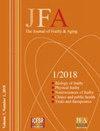Performance of a Novel Handheld Bioelectrical Impedance Device for Assessing Muscle Mass in Older Inpatients
IF 3.3
Q2 GERIATRICS & GERONTOLOGY
引用次数: 0
Abstract
To investigate practicality and repeatability of a handheld compared to a state-of-the-art multisegmental bioelectrical impedance analysis (BIA) device to facilitate screening of sarcopenia in older inpatients. Cross-sectional study in a geriatric rehabilitation hospital. 207 inpatients aged 70+. In a first phase, appendicular skeletal muscle mass index (ASMI) was measured using the handheld Biody xpertZm II BIA device (n=100). In a second phase, ASMI was obtained using the multisegmental Biacorpus RX 4004M device (n=107). Repeatability of BIA devices was compared in subgroups of patients (handheld BIA device: n=36, multisegmental BIA device: n=46) by intra-class correlation (ICC) and Bland-Altman plots. Overall, measurement failure was seen in 31 patients (31%) tested with the handheld BIA device compared to one patient (0.9%) using the multisegmental BIA device (p<0.001). Main reasons for measurement failure were inability of patients to adopt the position necessary to use the handheld BIA device and device failure. The mean difference of two ASMI measurements in the same patient was 0.32 (sd 0.85) using the handheld BIA device compared to 0.02 kg/m2 (sd 0.07) using the multisegmental device (adjusted mean difference between both groups −0.35, 95% confidence interval (CI) −0.61 to −0.09 kg/m2). Congruently, Bland-Altman plots showed poor agreement with the handheld compared to the multisegmental BIA device. The handheld BIA device is neither a practical nor reliable device for assessing muscle mass in older rehabilitation inpatients.一种用于评估老年住院患者肌肉质量的新型手持式生物电阻抗装置的性能
研究手持式与最先进的多节段生物电阻抗分析(BIA)设备的实用性和可重复性,以促进老年住院患者肌肉减少症的筛查。某老年康复医院的横断面研究。70岁以上住院患者207例。在第一阶段,使用手持Biody xpertZm II BIA装置测量阑尾骨骼肌质量指数(ASMI) (n=100)。在第二阶段,使用多节段Biacorpus RX 4004M设备获得ASMI (n=107)。通过类内相关(ICC)和Bland-Altman图比较不同亚组患者(手持BIA装置:n=36,多节段BIA装置:n=46) BIA装置的重复性。总体而言,与使用多节段BIA装置的1例患者(0.9%)相比,使用手持式BIA装置的31例患者(31%)测量失败(p<0.001)。测量失败的主要原因是患者无法采用使用手持BIA装置所需的体位和装置故障。在同一患者中,使用手持式BIA装置的两次ASMI测量的平均差异为0.32 (sd 0.85),而使用多节段装置的ASMI测量的平均差异为0.02 kg/m2 (sd 0.07)(两组调整后的平均差异为- 0.35,95%可信区间(CI) - 0.61至- 0.09 kg/m2)。与此同时,Bland-Altman图显示手持设备与多节段BIA设备的一致性较差。手持式BIA装置对于评估老年康复住院患者的肌肉质量既不实用也不可靠。
本文章由计算机程序翻译,如有差异,请以英文原文为准。
求助全文
约1分钟内获得全文
求助全文
来源期刊

Journal of Frailty & Aging
GERIATRICS & GERONTOLOGY-
CiteScore
5.90
自引率
7.70%
发文量
54
期刊介绍:
The Journal of Frailty & Aging is a peer-reviewed international journal aimed at presenting articles that are related to research in the area of aging and age-related (sub)clinical conditions. In particular, the journal publishes high-quality papers describing and discussing social, biological, and clinical features underlying the onset and development of frailty in older persons. The Journal of Frailty & Aging is composed by five different sections: - Biology of frailty and aging In this section, the journal presents reports from preclinical studies and experiences focused at identifying, describing, and understanding the subclinical pathophysiological mechanisms at the basis of frailty and aging. - Physical frailty and age-related body composition modifications Studies exploring the physical and functional components of frailty are contained in this section. Moreover, since body composition plays a major role in determining physical frailty and, at the same time, represents the most evident feature of the aging process, special attention is given to studies focused on sarcopenia and obesity at older age. - Neurosciences of frailty and aging The section presents results from studies exploring the cognitive and neurological aspects of frailty and age-related conditions. In particular, papers on neurodegenerative conditions of advanced age are welcomed. - Frailty and aging in clinical practice and public health This journal’s section is devoted at presenting studies on clinical issues of frailty and age-related conditions. This multidisciplinary section particularly welcomes reports from clinicians coming from different backgrounds and specialties dealing with the heterogeneous clinical manifestations of advanced age. Moreover, this part of the journal also contains reports on frailty- and age-related social and public health issues. - Clinical trials and therapeutics This final section contains all the manuscripts presenting data on (pharmacological and non-pharmacological) interventions aimed at preventing, delaying, or treating frailty and age-related conditions.The Journal of Frailty & Aging is a quarterly publication of original papers, review articles, case reports, controversies, letters to the Editor, and book reviews. Manuscripts will be evaluated by the editorial staff and, if suitable, by expert reviewers assigned by the editors. The journal particularly welcomes papers by researchers from different backgrounds and specialities who may want to share their views and experiences on the common themes of frailty and aging.The abstracting and indexing of the Journal of Frailty & Aging is covered by MEDLINE (approval by the National Library of Medicine in February 2016).
 求助内容:
求助内容: 应助结果提醒方式:
应助结果提醒方式:


